Featured This Month
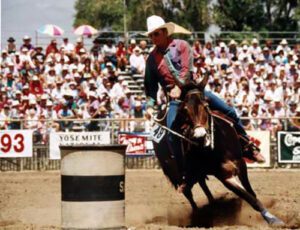
MULE CROSSING: Surge of Mule Shows
All Articles
MULE CROSSING: Suitability of Donkeys and Mules For Children
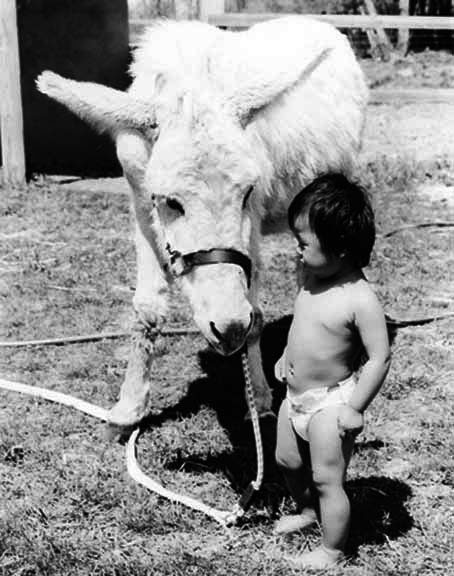 By Meredith Hodges
By Meredith Hodges
Many have inquired as to the suitability of mules and donkeys for children. As with any equine, choosing the right individual for your child is of primary importance. However, as a general rule, we find that donkeys make excellent mounts for beginning riders because of their patient, quiet nature and good common sense. They can be the best possible babysitter. There are things to consider when choosing a donkey for your child:
The first rule to observe is never get a donkey jack for your child! Though he may be sweet and docile by nature, he is still governed by strong natural instincts so his character is not consistent. He is a stud and must be treated as such.
Donkey jennets are good prospects for children provided they are not in heat or in foal. When a jennet is in heat she may become cross and if she is in foal, or has one at her side, she is also governed by instinct for the protection and welfare of her offspring.
The best possible mount for a child is a donkey gelding. He possesses all the positive traits of the donkey without being subject to primitive instincts. Since most donkeys are small in size and possess an affectionate attitude, they make excellent companions as well as mounts for children.
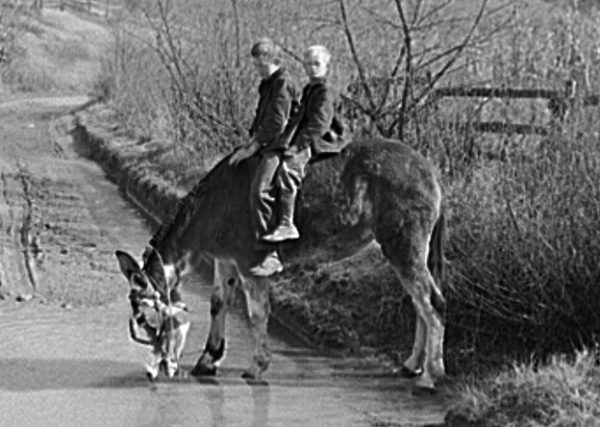 Since a donkey can became quite stubborn when treated badly, it is important that you take the time to help your child and donkey get started properly. Even an untried donkey with proper help can be a wonderful mount for a child. In the first few weeks, the child and donkey should simply spend time getting to know one another. Teach your child the correct way to handle and groom the donkey. The personal bond between them will develop on its own.
Since a donkey can became quite stubborn when treated badly, it is important that you take the time to help your child and donkey get started properly. Even an untried donkey with proper help can be a wonderful mount for a child. In the first few weeks, the child and donkey should simply spend time getting to know one another. Teach your child the correct way to handle and groom the donkey. The personal bond between them will develop on its own.
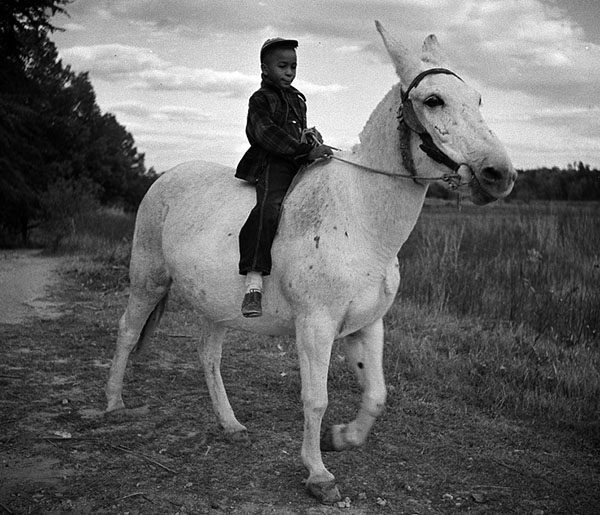 When your child and donkey have developed confidence in each other, you can begin to teach them the fundamentals of riding. Tack up the donkey in a small saddle and snaffle bridle and take him into a small pen on the lunge line. Allow your child to sit astride the donkey as he walks around you. Explain to your child the basics of turning and stopping with a direct rein, commonly called plow reining. Be sure to instruct the child not to pull hard or jerk the reins. Donkeys have very sensitive mouths and do not respond correctly when they are in pain.
When your child and donkey have developed confidence in each other, you can begin to teach them the fundamentals of riding. Tack up the donkey in a small saddle and snaffle bridle and take him into a small pen on the lunge line. Allow your child to sit astride the donkey as he walks around you. Explain to your child the basics of turning and stopping with a direct rein, commonly called plow reining. Be sure to instruct the child not to pull hard or jerk the reins. Donkeys have very sensitive mouths and do not respond correctly when they are in pain.
Teach your child to use verbal commands in conjunction with the reins and leg cues. When he wants to go forward for instance, tell your child to ask the donkey to walk. Tell the child to squeeze with his legs – don’t just kick. He should get the desired response. If the child wishes to turn, tell him to ask the donkey to “Haw” (left) or “Gee” (right). Instruct the child to pull gently on the direct rein and push the donkey into the turn with the opposite leg. When stopping, tell the child to first say “Whoa,” and then pull gently on the reins and sit deeper in the saddle to initiate the stop. When the donkey complies with the commands given, do not be afraid to reward him. He will be more than willing to perform the next time you ask him.
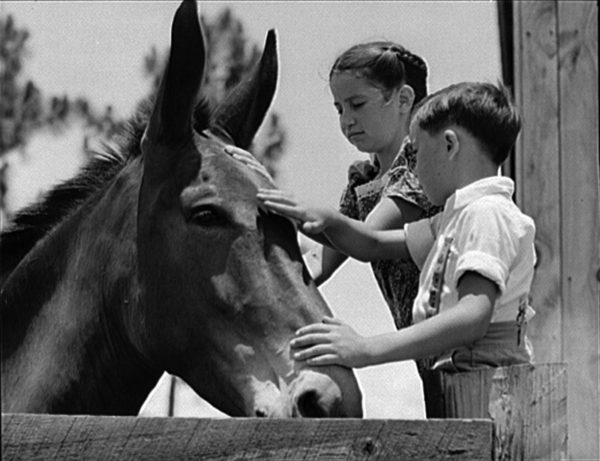 Love and caresses are an excellent reward and a reward of crimped oats certainly does no harm. Donkeys are very appreciative animals. If the child and donkey are supervised correctly, it can greatly enhance the entire riding experience. The donkey will protect your child with his excellent judgment and the child will learn to be a patient and understanding person through interaction with his donkey. The reason is simple; donkeys will not respond unless treated fairly. Many an equestrian in Great Britain has spent his early years astride a donkey and have become better riders because of it! So if your child expresses an interest in riding, consider starting with a donkey gelding, or maybe even a jennet. Besides being patient with children, his size is more suitable, he has ample strength to carry them and is an easy keeper so feed and vet bills can usually be kept at a minimum.
Love and caresses are an excellent reward and a reward of crimped oats certainly does no harm. Donkeys are very appreciative animals. If the child and donkey are supervised correctly, it can greatly enhance the entire riding experience. The donkey will protect your child with his excellent judgment and the child will learn to be a patient and understanding person through interaction with his donkey. The reason is simple; donkeys will not respond unless treated fairly. Many an equestrian in Great Britain has spent his early years astride a donkey and have become better riders because of it! So if your child expresses an interest in riding, consider starting with a donkey gelding, or maybe even a jennet. Besides being patient with children, his size is more suitable, he has ample strength to carry them and is an easy keeper so feed and vet bills can usually be kept at a minimum.
What of the suitability of a mule for child? As the mule is half donkey, he possesses many of the fine 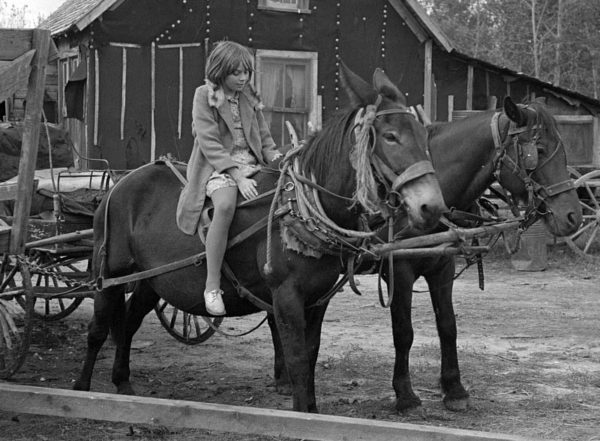 characteristics that make him suitable for children. But at this point I must caution you that he is also part horse and will generally get his disposition from the mare. So if you wish to get a mule for your child, be sure he is an individual with a quiet disposition. Then you can consider such things as size, color and other traits. The right mule can be just as good a babysitter as the right donkey, and usually more reliable than any horse!
characteristics that make him suitable for children. But at this point I must caution you that he is also part horse and will generally get his disposition from the mare. So if you wish to get a mule for your child, be sure he is an individual with a quiet disposition. Then you can consider such things as size, color and other traits. The right mule can be just as good a babysitter as the right donkey, and usually more reliable than any horse!
Children and donkeys or mules, have not been seen together much in this country in the more recent past. Perhaps it is because we have not given children a chance to show their Longears publicly. Realizing this need, as in horse shows, youth classes have been included in the Longears shows of today to encourage our youth to take an active interest in the promotion of Longears. The jobs these “kids” are doing with their mules and donkeys are marvelous and their contributions are extensive. The values learned by children when dealing with donkeys and mules will stand them in good stead throughout their lives, not to mention the joy they will discover in having such a companion. So during this season of giving, consider making Longears a part of your life and give a homeless donkey, burro or mule a chance. Your child will welcome this affectionate and sensible companion. If you adhere to the guidelines I have given to you, you should not be disappointed.
To learn more about Meredith Hodges and her comprehensive all-breed equine training program, visit LuckyThreeRanch.com, MEREDITH HODGES PUBLIC FIGURE Facebook page, or call 1-800-816-7566. Check out her children’s website at JasperTheMule.com. Also, find Meredith on Pinterest, Instagram, MeWe, YouTube and Twitter.
© 1985, 2016, 2018, 2021, 2024 Lucky Three Ranch, Inc. All Rights Reserved.
MULE CROSSING: Driving Activities
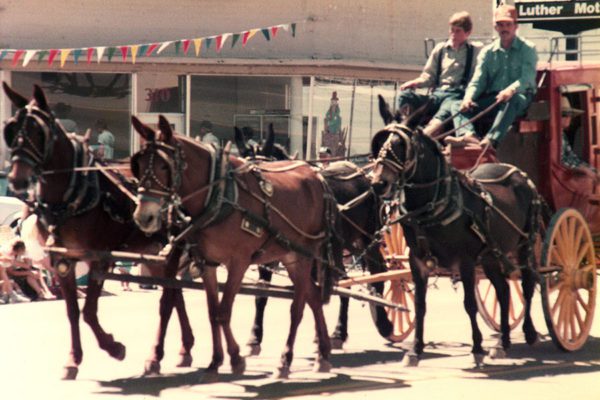 By Meredith Hodges
By Meredith Hodges
With the introduction of the automobile came decreased interest in horse-drawn vehicles. Tractors replaced equine-driven vehicles in the fields. It seemed as if equines had been put out of a job! But, as with any change, this was only temporary. Modern society still has need of equine participation, especially from donkeys and mules. The well-schooled driving donkey or mule is much safer and more reliable than any horse. The reason for this is the donkey and mules’ natural sensibility and their positive response to verbal communication. Once they have learned the parameters of their job, if treated fairly, they will calmly and diligently go about their business, flicking their ears back and forth toward the driver, always listening for verbal reinforcement of their behavior. In a pinch, they can more often be prevented from “freaking out” with a few calm and reassuring words. Their strength and durability enables them to work longer and harder hours than can a horse and their variety of sizes and colors provides them as suitable driving animals for a number of driving-related activities.
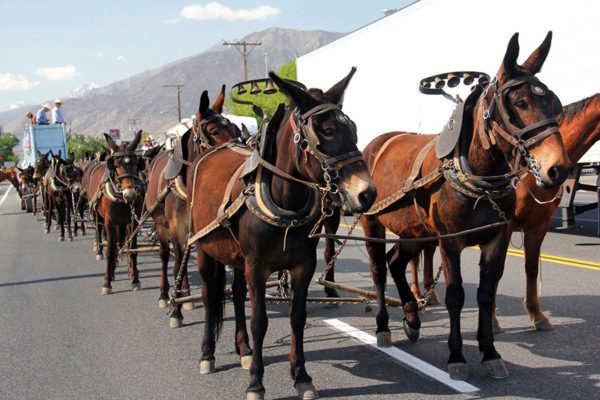 Most often we see driving animals in parades. Although it seems simple enough to drive down a parade route, there are a number of things to consider that can complicate the issue. Parade routes are lined with potential hazards and an overload of outside stimuli. Horses that become spooked have been known to bolt and actually run right through crowds of people. I have yet to hear of a donkey or mule that has done such a thing! Perhaps it is because the donkey or mule will not run into trouble if he can possibly avoid it. He will also be more likely to rely upon his driver for support and direction through the safest route. He will stop if in doubt of a situation when properly trained. Mules and donkeys are familiar with teamwork and will work as a team with their driver. The frightened horse just says, “Forget you!” and leaves!
Most often we see driving animals in parades. Although it seems simple enough to drive down a parade route, there are a number of things to consider that can complicate the issue. Parade routes are lined with potential hazards and an overload of outside stimuli. Horses that become spooked have been known to bolt and actually run right through crowds of people. I have yet to hear of a donkey or mule that has done such a thing! Perhaps it is because the donkey or mule will not run into trouble if he can possibly avoid it. He will also be more likely to rely upon his driver for support and direction through the safest route. He will stop if in doubt of a situation when properly trained. Mules and donkeys are familiar with teamwork and will work as a team with their driver. The frightened horse just says, “Forget you!” and leaves!
Driving competitions are becoming more popular than ever these days as a number of different types of driving classes are being made available to contestants. For the really serious competitor, there are pleasure, obstacle, and Reinsmanship classes in which to measure one’s progress in performance.
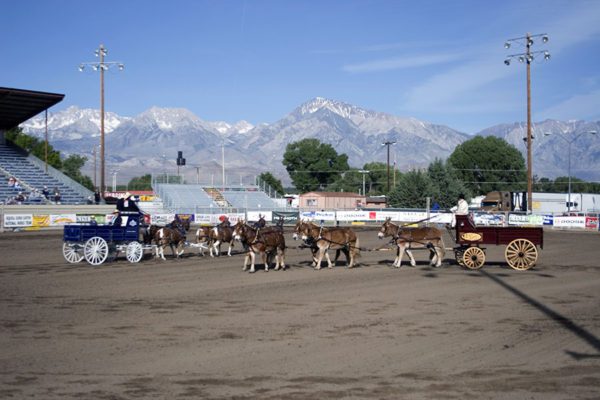 As the competitor improves, he may move into marathon driving, testing his skills across country and through obstacles (called hazards). The driver may use singles, or teams, depending on his personal preference. The American Driving Society has been more than generous, allowing mules and donkeys to compete in most of their events right along with the horses. For more fun-loving competitors, there are a lot of different driving games, gauged for the ability of the competitors. This allows even the most inexperienced driver some source of enjoyment from which he can derive a sense of accomplishment and excitement.
As the competitor improves, he may move into marathon driving, testing his skills across country and through obstacles (called hazards). The driver may use singles, or teams, depending on his personal preference. The American Driving Society has been more than generous, allowing mules and donkeys to compete in most of their events right along with the horses. For more fun-loving competitors, there are a lot of different driving games, gauged for the ability of the competitors. This allows even the most inexperienced driver some source of enjoyment from which he can derive a sense of accomplishment and excitement.
For those who want to enjoy a nice day in the country with their animals, there are rallies and organized picnic drives. This type of driving is more relaxing, but no less rewarding and satisfying than competitive events. Awards are sometimes given at rallies for coming in closest to the optimum time, but the pace is usually quite leisurely! Your donkey or mule will love the alternative to showing and will enjoy the activities as much as you do.
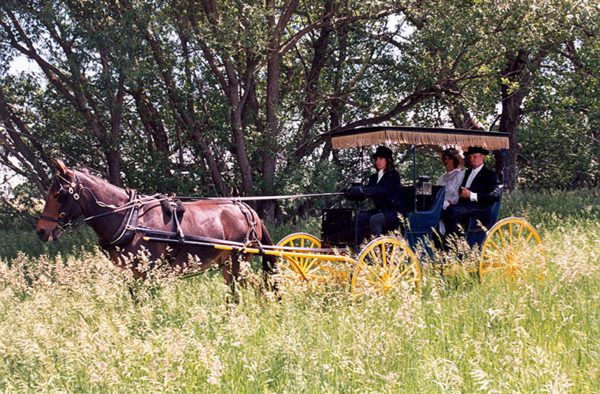 Mules and donkeys are used in many tourist areas, pulling cabs and carriages of all varieties, taking tourists in a more leisurely fashion through the streets of history and tradition. Couples can romantically celebrate special moments in their relationships with a relaxing ride in a special cab or buggy. The sensible mule or donkey assures a safe and romantic memory that will stay with you for the rest of your life! We have used our mules to pull carriages for weddings and receptions, adding a touch of class and a little tradition to an otherwise fast-paced and chaotic world!
Mules and donkeys are used in many tourist areas, pulling cabs and carriages of all varieties, taking tourists in a more leisurely fashion through the streets of history and tradition. Couples can romantically celebrate special moments in their relationships with a relaxing ride in a special cab or buggy. The sensible mule or donkey assures a safe and romantic memory that will stay with you for the rest of your life! We have used our mules to pull carriages for weddings and receptions, adding a touch of class and a little tradition to an otherwise fast-paced and chaotic world!
Because of their thoughtful and affectionate nature, donkeys and mules are ideal candidates for handicapped and disabled drive and ride programs. They are not as abruptly spooked as horses, and are therefore less likely to unseat a disabled rider, or run off with a disabled driver. Horses have fared reasonably well in riding programs for the disabled and handicapped, but are not really reliable enough for driving programs of this kind. This is where Longears can excel! Mule and donkey drive and ride programs, such as the Slade Centre at the Donkey Sanctuary in Great Britain, afford disabled and handicapped people the opportunity to enjoy the wonders of nature by offering them more mobility with the assistance of a new “friend” who is gentle and affectionate. These “friends” replace hopelessness with joy and fulfillment, helping to make life worth living!
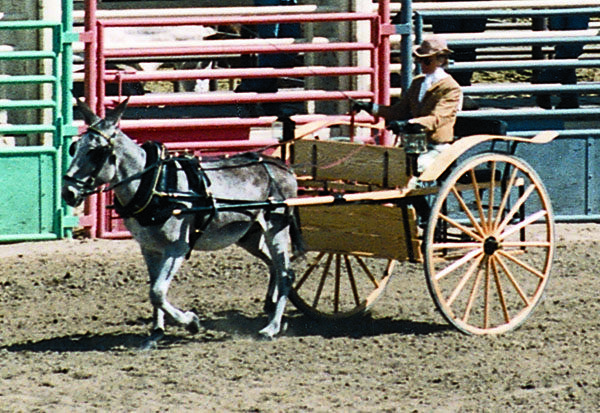
Driving itself is a wonderful recreation for just about anyone, from the smallest child to the eldest grandmother. Driving donkeys or mules gives you that extra sense of security in an otherwise potentially dangerous situation. Driving a donkey or mule can provide a companion and friend to otherwise lonely and unfulfilled persons, keeping life more positive and enjoyable. Riding equines for enjoyment still requires a certain amount of training and practice. Learning to drive requires a lot less training and practice time for the driver, provided that the animal is well-schooled and obedient. Small farms today still use mules and donkeys for farm work. When they know their job, they do it with ease and sometimes work exclusively on verbal communication. Old farmers speak of their mules with pride and affection. It’s nice to have a “hand” that doesn’t talk back and isn’t afraid of a little hard work! In this fast-paced world, sometimes it’s nice to go a little slower and take in all the beautiful and fulfilling things that life has to offer, like a relaxing drive in the country with your very best friend!
To learn more about Meredith Hodges and her comprehensive all-breed equine training program, visit LuckyThreeRanch.com, MEREDITH HODGES PUBLIC FIGURE Facebook page, or call 1-800-816-7566. Check out her children’s website at JasperTheMule.com. Also, find Meredith on Pinterest, Instagram, MeWe, YouTube and Twitter.
© 1992, 2016, 2018, 2022, 2024 Lucky Three Ranch, Inc. All Rights Reserved.
MULE CROSSING: Showing in Harness
By Meredith Hodges
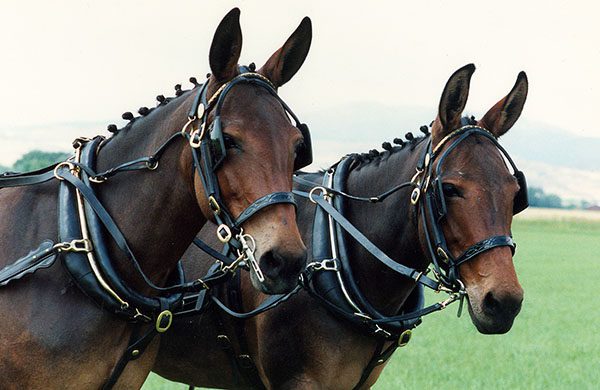 Now that you have spent many months teaching your mule to drive and he is doing so well, you have decided that it might be fun to show him in harness. So, what are that kinds of things that a judge looks for in a driving class of mules? Well, it’s basically the same as it is with horses.
Now that you have spent many months teaching your mule to drive and he is doing so well, you have decided that it might be fun to show him in harness. So, what are that kinds of things that a judge looks for in a driving class of mules? Well, it’s basically the same as it is with horses.
The first and foremost consideration for a judge is your mule’s manners. His manners will exhibit just how safe your mule is for driving. As with people, a judge can get an overall impression from the expression on your mule’s face! An attentive and pleasant expression is definitely preferred. The expression on his face will reflect his overall comfort within a situation. If he is comfortable, he responds to minimal aids calmly, confidently, yet promptly. He should reinback easily upon request, and stand quietly at the halt with all four legs squared. His ears will be relaxed, but attentively turned to the driver most of the time. Ears that are rapidly in motion indicate anxiety and distraction.
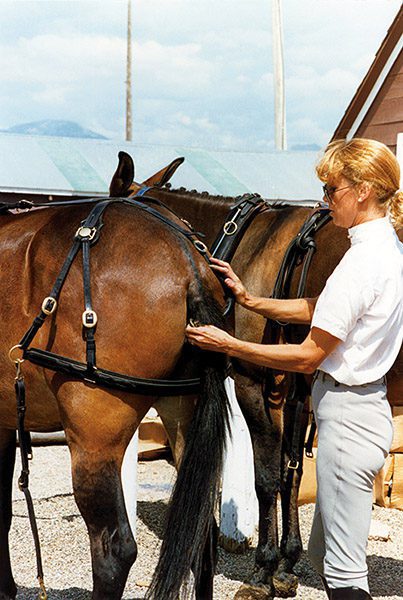 A major contributing factor in your mule’s overall manners is his conditioning. If your mule has been brought along with a carefully planned exercise program, his muscle growth and strength will increase with little or no stress, as it should in most athletes. The mule that is conditioned in this way will have the strength to pull while maintaining a smooth, steady and effortless gait. He is comfortable in his work. Properly conditioned mules will not exhibit the tenseness that comes from overexertion, a tenseness that can inhibit his entire performance.
A major contributing factor in your mule’s overall manners is his conditioning. If your mule has been brought along with a carefully planned exercise program, his muscle growth and strength will increase with little or no stress, as it should in most athletes. The mule that is conditioned in this way will have the strength to pull while maintaining a smooth, steady and effortless gait. He is comfortable in his work. Properly conditioned mules will not exhibit the tenseness that comes from overexertion, a tenseness that can inhibit his entire performance.
How can you tell if your mule is well-conditioned? Touching his body with your fingers at the neck, shoulders, barrel, loins, stifles and rump can tell you a lot. These muscles should be hard and not mushy to the touch. Standing behind your mule, you should begin to see considerable gaskin development. A driving class lasts approximately 20 to 30 minutes. If you condition your mule at the medium trot for 20 minutes straight, without any sweating or breathing hard, he should be able to handle the class with no problem. Another helpful hint is to condition him on uneven ground. Then, when he performs on the flat ground, it will seem a lot easier to him. Remember to condition slowly to avoid overexertion, muscle soreness or injury. If you condition your mule beyond what is expected in the class, you won’t have to worry about him being fit for class! And, as long as he is so well conditioned, be sure he is well-groomed as well.
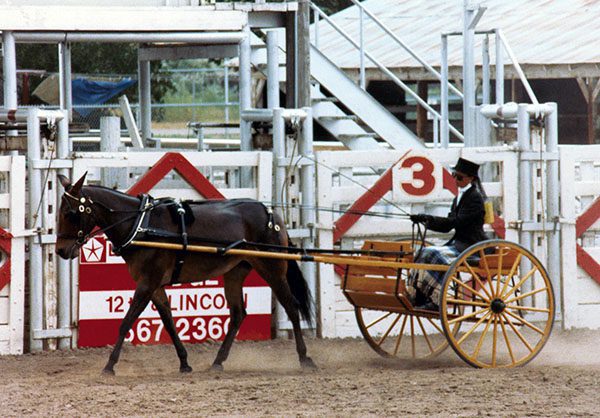 Your mule’s way of going is another important consideration for the judge. In the driving class, your mule will be asked for the walk, collected trot, working trot and the reinback. The walk should be “regular and unconstrained, energetic, but calm with even and determined steps with distinctively marked four equally spaced beats.” In the collected trot, “the neck is raised, thus enabling the shoulders to move with greater ease in all directions, the hocks well-engaged and maintaining energetic impulsion not withstanding the slower movement.” The mule’s steps are shorter, but are lighter and more mobile. The working trot is a pace between the collected and extended trots. The mule “goes forward freely and straight, engaging the hind legs
Your mule’s way of going is another important consideration for the judge. In the driving class, your mule will be asked for the walk, collected trot, working trot and the reinback. The walk should be “regular and unconstrained, energetic, but calm with even and determined steps with distinctively marked four equally spaced beats.” In the collected trot, “the neck is raised, thus enabling the shoulders to move with greater ease in all directions, the hocks well-engaged and maintaining energetic impulsion not withstanding the slower movement.” The mule’s steps are shorter, but are lighter and more mobile. The working trot is a pace between the collected and extended trots. The mule “goes forward freely and straight, engaging the hind legs 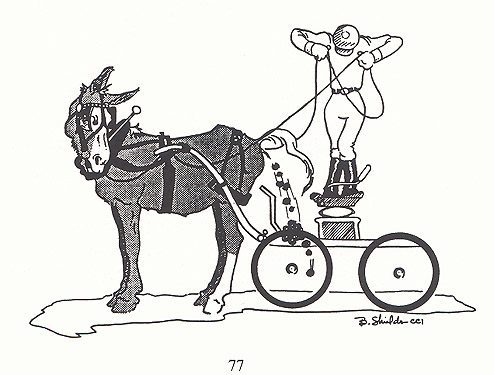 with good hock action, on a taut, but light rein, the position being balanced and unconstrained. The steps are
with good hock action, on a taut, but light rein, the position being balanced and unconstrained. The steps are
even as possible and the hind feet touch the ground in the foot prints of the fore feet.” The reinback is “a kind of walk backwards. The legs being raised and set down simultaneously by diagonal pairs, the hind legs remaining well in line and the legs being well raised.” The mule that is conditioned slowly with special attention given to core strength, straightness, balance and bend will begin to carry himself in good equine posture and exhibit these true gaits naturally after a period of practice time.
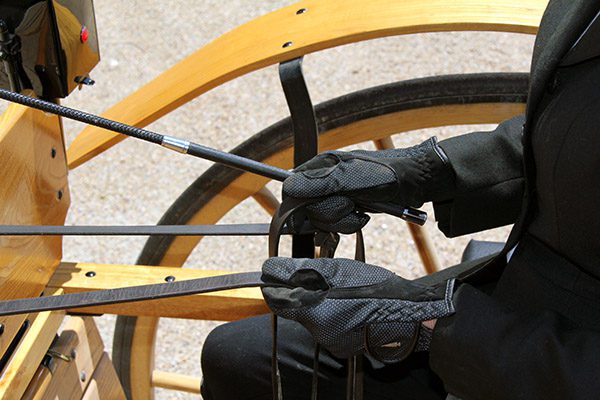 The next consideration is the appropriateness of the animal to the vehicle he is pulling. A smaller mule should never be used to pull a large wagon, nor should the larger draft mule be used to pull a pony cart! Select a vehicle that pulls easily for your mule and one that is proportionate to his size. The overall picture should be balanced and harmonious. Fifty percent of your total class score will include your mule’s manners, his conditioning, his way of going and the appropriateness of the general turnout.
The next consideration is the appropriateness of the animal to the vehicle he is pulling. A smaller mule should never be used to pull a large wagon, nor should the larger draft mule be used to pull a pony cart! Select a vehicle that pulls easily for your mule and one that is proportionate to his size. The overall picture should be balanced and harmonious. Fifty percent of your total class score will include your mule’s manners, his conditioning, his way of going and the appropriateness of the general turnout.
Twenty percent of your total score is judged on you, the whip or teamster. Your hands should be held at waist level, about three inches in front of your body and about 10 inches apart. “A rein passes between the forefinger and middle finger of each hand and is held secure with pressure from the thumb; the whip is held in the right hand.” You should always sit in good posture and the use of your aids should be almost imperceptible. An expert Reinsman rarely exceeds a 12″ imaginary box around his hands. Your dress should be appropriate to the vehicle in which you ride.
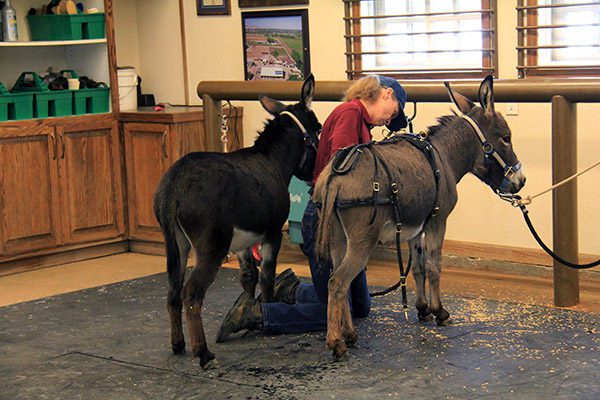 For instance, a formal coach would require a more formal dress than would a two-wheel country cart. Dress must be conservative for the times. Western dress is permitted where appropriate. Hat, gloves, coat, tie, and a lap apron are required. A whip must be held in hand at all times! Always look where you are going, check the judge for instructions periodically and pay attention to spacing in the arena! The remaining considerations for a judge are the vehicle and the harness with each carrying 15% of your total score. The vehicle should be in good repair, appropriate size and style for your mule, and should fit him properly through the shafts and tugs. The harness should fit him as well as possible and should be adjusted correctly, especially the breeching so it can do its job in the reinback.
For instance, a formal coach would require a more formal dress than would a two-wheel country cart. Dress must be conservative for the times. Western dress is permitted where appropriate. Hat, gloves, coat, tie, and a lap apron are required. A whip must be held in hand at all times! Always look where you are going, check the judge for instructions periodically and pay attention to spacing in the arena! The remaining considerations for a judge are the vehicle and the harness with each carrying 15% of your total score. The vehicle should be in good repair, appropriate size and style for your mule, and should fit him properly through the shafts and tugs. The harness should fit him as well as possible and should be adjusted correctly, especially the breeching so it can do its job in the reinback.
Often, it is difficult to find horse harnesses that will fit the lighter and smaller mules or donkeys properly, but you can approximate the size you need (i.e. pony, cob, horse, draft) and then make the necessary adjustments, or 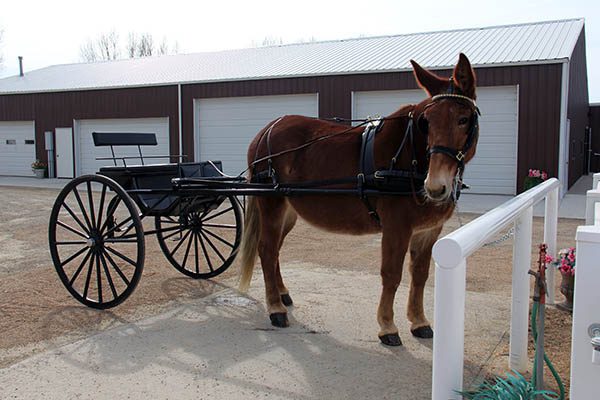 have a professional harness-maker help you. Your mule should be fastened snugly to the vehicle. Be sure that your collar or breast collar fits your mule properly as this can create soreness and make for a very unhappy mule! Adjust the breeching snugly enough to make your “brakes” effective! One of the most common mistakes made by beginning drivers is adjusting the breeching too loose. This makes it difficult for your mule to either slow down or back straight and evenly, and the resulting slack will make his transitions look abrupt and awkward!
have a professional harness-maker help you. Your mule should be fastened snugly to the vehicle. Be sure that your collar or breast collar fits your mule properly as this can create soreness and make for a very unhappy mule! Adjust the breeching snugly enough to make your “brakes” effective! One of the most common mistakes made by beginning drivers is adjusting the breeching too loose. This makes it difficult for your mule to either slow down or back straight and evenly, and the resulting slack will make his transitions look abrupt and awkward!
There is a lot to consider as a driving judge, but judges are also human beings, and basically the judge is going to select those mules for placement in the class that HE would most like to drive. If you follow the guidelines that I have described, your Longears will be one of the judge’s favorites!
To learn more about Meredith Hodges and her comprehensive all-breed equine training program, visit LuckyThreeRanch.com, MEREDITH HODGES PUBLIC FIGURE Facebook page, or call 1-800-816-7566. Check out her children’s website at JasperTheMule.com. Also, find Meredith on Pinterest, Instagram, MeWe, YouTube and Twitter.
© 1991, 2016, 2019, 2021, 2023, 2024 Lucky Three Ranch, Inc. All Rights Reserved.
